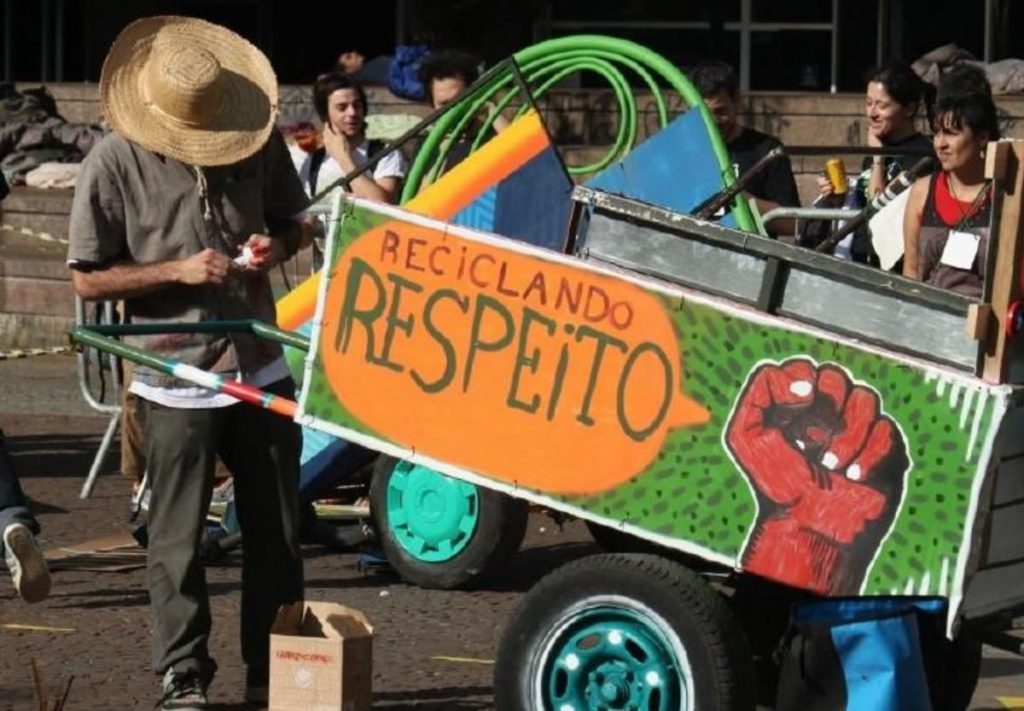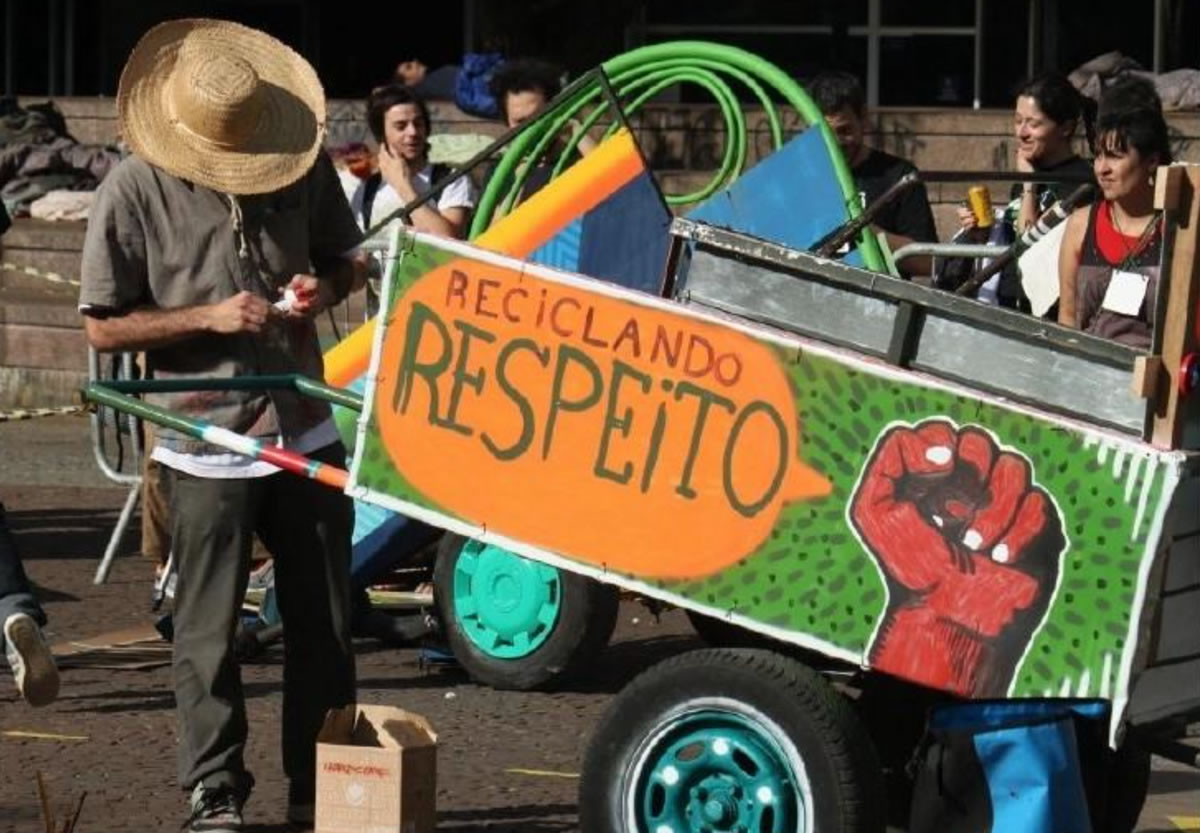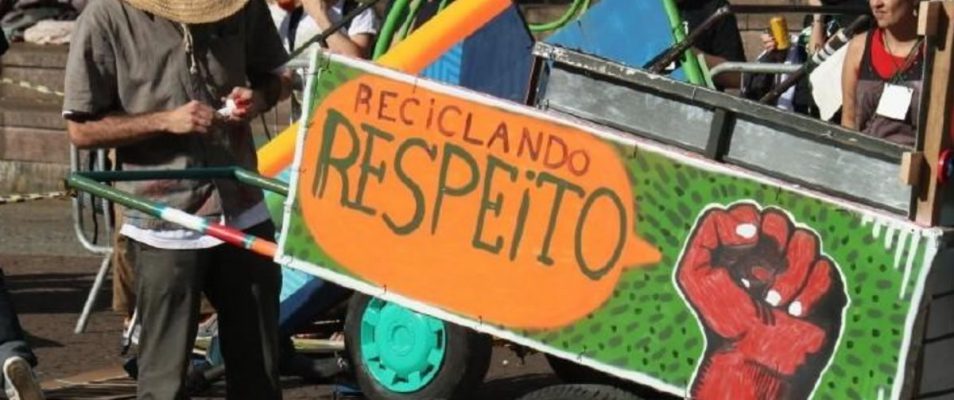Artivism, street art and the Global Impact of “Pimp My Carroça”
The essence of street art is to appeal to many people given that it is a form of art done in public areas, which may be perceived as unusual. Diverse art forms, like graffiti, and stencil, which are the ones I am approaching in this post with the “Pimp My Carroça” project, contribute to the vibrant and ever-evolving nature of street art, transcending linguistic boundaries and expressing opinions on poverty, war, environmental pollution, and other important global issues. The incorporation of new media enhances the visibility and accessibility of many art forms, including art made on the streets. The use of online platforms allows activists to engage in actions that result in tangible transformations within both the legal and corporate spheres on a global scale (O’Donnel & Sweetman, 2018). Applications such as Instagram, Twitter, and YouTube make for easy dissemination of street art in a manner that is not limited by geographical boundaries. As the content goes viral, the art and its advocacy become more expansive and powerful.
This piece will analyse the Pimp My Carroça project, a Brazilian street art initiative that expanded and is now all over the world and especially within Latin America. This paper aims to analyse the importance of street art and its capacity to generate awareness and facilitate social discourse on the marginalisation of people and groups. Additionally, it will explore how the advent of new media has further amplified the impact of street art in this context.
Street art was also the theme for my earlier post in this blog, where I talked a bit about Banksy’s art in Palestine and you can read it here.
A brief talk on Street Art and Artivism
When Mesías-Lema (2018) talks about art activism or artivism, he says,
Artivism is a neologism derived from “art” and “activism” … the term describes artists who are committed to creative processes of an activist nature but not activists who resort to art as a form of vindication. (p. 20-21)
These artivism activities are meant to spark conversations about social or political problems in order to make those better. Since the beginning of time, artists have used their skills to talk about wrongs, unfairness, and modern social problems. This kind of activity has the power to reach people across language barriers and stir up emotions that demand conversation and group action. Street art is a powerful way to illustrate both parties, art and activism, coming together and influencing each other.
Street art has become much more common because it covers bus stops, goes up in back alleys, hides signs, competes with advertising, and basically acts as a background for everything in the cities all over. The work include a lot of graffiti, big ads and neighbourhood flyers, which take up our whole field of vision. We learned how to recognise and describe visual problems caused by too many and too close visual cues. But recently, there has been a slow change towards liking visually appealing content over the visually unappealing content that was more common in the past. Art that is clever, witty, critical, ironic, and sarcastic is showing up in strange and surprising places because of this new trend. People in general like and accept this new trend more than most modern art (Bacharach, 2018).
A Universal Visual Language Enhanced by New Media
Street art triggers conversations that are trans-temporal and trans-spatial, with cultural exchanges and a global dialogue. It also translates to a very special and unique type of action. When street artists don’t take their work into museums but into everyday life, they don’t just say what they think about the world – they step in and change it with their art. Artists on the street can actively create a different world to live in by putting art into the real world instead of the art world. There is a line between art and an act of protest when it comes to street art (Bacharach, 2018).
It integrates with new media outlets, thus fostering communication among people of diverse cultures and giving them a lingua franca which makes it comprehensive and understandable interchangeably, facilitating to work as a team effectively, towards the same goal. The global conversation is integral for international development operations, such as climate change and gender equality claims, as one views and understands issues in a similar manner when addressing problems confronting the whole globe.
Also, street art, most particularly in the smaller towns, is a means through which people’s power, as well as voice, can be achieved. That is why it offers us an opportunity to share and store the events of life that happened within groups around the world through new media. With this merging, opinions which are not heard often receive added importance while a focus on local concerns and needs is drawn. In this way, new media action becomes a progressive tool since it enhances the voices of common citizens and offers answers for openness and community oriented ones.
Karen Frost-Arnold (2016), talks about social media as a means of enhancing the reach of protests:
… online acts of hopeful trust that reach a large audience may provide enough motivation to some susceptible audience members that it inspires them to change. It is the possibility for this kind of change that makes it sometimes effective to use social media to challenge privilege and prejudice. (p. 527)
Symbols are another instance where street art, such as graffiti and stencil, can be used as a means for developing a common visual language. Symbols are a favourite expression style for graffiti artists who express their emotions on various complex issues that they hold a personal opinion on. For instance, an upraised fist symbolizes resistance and oppression, while a dove signifies peace. As mentioned before, it has now become easier for graffiti artists to disseminate their work to a global audience through new media platforms like social media and connect with fellow graffiti artists from all over the globe. As a result, a global graffiti community emerged, which allows artists to exchange images depicting their works, express their thoughts and participate in joint projects.
As a case in point, the Instagram page of @globalstreetart showcases graffiti from every corner around the globe. The account has more than three hundred thousand followers and it serves to introduce people to graffiti from several cultures. Moreover, there are more than fifty million posts with the hashtag #graffiti on Instagram; this emphasizes the worldwide outreach of graffiti.
Overall, street art is a great communication tool because everyone can understand it. New media has given graffiti artists a bigger voice, starting a conversation around the world about graffiti as fine art.
Brazilian Street Art Initiative Pimp My Carroça
In Brazil and Latin America street art is full of political symbolism (Bogerts, 2022) and I want to highlight an organisation named Pimp My Carroça. The project was born in 2012 in São Paulo with the initiative to improve labour conditions and promote social integration for those engaged in the collection of recyclable materials, the so-called waste pickers, as well as cart drivers and their respective families.

The project was conceived by Mundano, an artist known for his graffiti work. It aimed to create a parody of popular television programmes that focus on the renovation of cars, with the intention of both enhancing the quality of life for these workers and increasing public recognition of their significance within urban environments (Martins & Campos, 2016). The now renowned graffiti street artist and human rights activist Mundano – you can check his awards on the project website (Pimp My Carroça, 2020) – is behind the initiative which uses artistic means such as symbols and visual language to foster consciousness, engagement, and transformation. The primary objective of this programme is to enhance public consciousness of the presence of these marginalised labourers among the bustling traffic of the city.
The act of collecting recyclables is indicative of socioeconomic disparities, unemployment rates, the prevalence of solid waste, and inherent problems within the collecting system. Although they play a vital role in society, they are not often classified as labourers. According to the artist, a significant portion, namely 90% of the nation’s recyclable waste is collected by these autonomous workers. Moreover, it is observed that a majority of individuals engage in independent operations, whereby they gather street garbage and then sell it to the local “scrapyard” at relatively low prices. In many Brazilian neighbourhoods, individuals have the capacity to move loads over 300 kg using bags, carts, bicycles, and other means constructed from wood or metal. These individuals operate carts amidst a mix of both lightweight and heavyweight motor vehicles.
Street Art as a Catalyst for Social Awareness
The Pimp My Carroça initiative seeks to foster a sense of respect and admiration for these sustainable and impactful workers among the general public. According to Mundano, waste pickers are globally seen as “invisible.” The activist claims that he has identified these workers worldwide, in locations such as Argentina, Chile, Bolivia, South Africa, and Turkey, as well as in several industrialised countries like the United States and Japan.
It all started with an idea, which lead to a crowdfunding campaign that went viral on social media among artists and common people, with incredible reach, according to a video promoted on Pimp My Carroça YouTube channel: “The campaign was a huge hit and investments exceeded expectations” (Video Case Pimp My Carroça, 2017, 1:18) and people started donating. In 2014, more than 500 volunteers gathered in São Paulo downtown where hundreds of carts were renovated and by the end of the day, hundreds of carts had been fixed up, painted, and made safer. In the meantime, the owners of the carts, the waste pickers, got medical help and services to improve their health and well-being, such as dentists, hairdressers, and barbers. They also got “pimped up”!
This work just portrays the first occurrence of the project in the year of 2014. Upon the dissemination of the project’s success, many municipalities in Brazil started promoting their own initiatives, receiving the constant support of the original creator, Mundano. Currently, the initiative has gained significant traction throughout Brazil and has subsequently extended its reach globally, as stated on the official Pimp My Carroça website. In the present day, the project is a nonprofit organization, that engages and collaborates with NGOs and educational institutions, obtaining financial resources from civil society, and public and private entities, making it one of the most accomplished Brazilian street art programmes. As a result, it offers the participants a distinct sense of identity and visibility, fostering social integration and improving the conditions in which they work.
Conclusions
Street art, particularly in initiatives like Pimp My Carroça in Brazil and Latin America, serves as a powerful medium for expressing social issues and instigating significant change. A worldwide and popular language emerges that may foster cross-border conversation about topics such as social injustice, the marginalisation of vulnerable populations, and the urgent need for societal transformation. New media can increase the spread of street art and advocacy; however, at the same time, one must acknowledge that technology does not automatically mean equal access or effect. The digital gap continues to persist on a global scale among disadvantaged areas, where access to necessary technology and opportunities for maximising benefits remains limited (Walsham, 2017). Additionally, the topic matter must remain relevant to encourage continuous debate.
Moreover, the use of media platforms, such as Twitter, Instagram, and YouTube, enables the dissemination of information to draw attention to important concerns, including economic hardship, environmental degradation, and other social inequalities.
Artivism, a term derived from the fusion of “art” and “activism,” as seen previously in this article encompasses a context in which artists assume the role of catalysts, using their artistic expressions to incite discourse, challenge conventional norms, and motivate others to do imperative actions. Even though street art has traditionally been associated with urban areas, it has become much more popular around the world thanks to the fast spread of new media technologies. This is because of how far technology has come. It has made it possible for street art to spread all over the world and for an international graffiti community to grow.
The intersection of art, activism, and new media has emerged as a focal point for recognising the importance of street art within the context of social engineering. The emergence of the project has provided disadvantaged communities with more agency, challenged established cultural norms, encouraged a global conversation on inclusivity, and enabled the recognition of individuals or groups who were previously overlooked. The underlying power of street art lies in its ability to deconstruct social divides, cultivate multicultural ties, and draw attention to relevant issues. This attribute makes it a powerful instrument for worldwide social transformation.
Listen to Mundano, the founder of Pimp My Carroça, at TED Talk so you can understand better about the project. I highly suggest also to watch the MiniDoc Pimp My Carroça with English subtitles.
Thank you for reading!
(2213 words)
Learning Reflections
Writing on the blog was an excellent practise for both my academic and professional careers. Because of the mix of scholarly and general public language, I gave it some consideration before sharing it. Finding the proper tone was an excellent learning experience.
When I initially joined our group, I thought we were well matched since we could identify common ground straight away. For the first time in this course, I had some difficulties since I was away in my home country for a few weeks and felt overwhelmed to not answer immediately to the group’s demands and could not keep up with the weekly courses as well.
I should mention that I got complete support from the team, which made suggestions for the most interesting material given in class sessions and discussed around issues and concerns. Despite the fact that practically all of the participants were in various time zones, and could be sort of hard to catch up, the group was always responding, encouraging me and being helpful. It was a genuinely collaborative effort, and I am grateful to have been a part of it!
See you next time, Group 7, you rock!
References
Bacharach, S. (2018). Finding Your Voice in the Streets: Street Art and Epistemic Injustice. The Monist, 101(1), 31–43.
Bogerts, L. (2022). The Aesthetics of Rule and Resistance: Analyzing Political Street Art in Latin America (29). Berghahn Books.
Davis, S. (2016). Relocating Development Communication: Social Entrepreneurship, International Networking, and South-South Cooperation in the Viva Rio NGO. International Journal of Communication, 10, 42–59.
Frost-Arnold, K. (2016). Social Media, Trust, and the Epistemology of Prejudice. Social Epistemology, 30(5–6), 513–531. http://dx.doi.org/10.1080/02691728.2016.1213326
Martins, V. S., & Campos, G. B. de. (2016). Graphic design and urban art as tools for social development. INTERAÇÕES, 17(4), 635–643. https://doi.org/10.20435/1984-042X-2016-v.17-n.4(07)
Noske-Turner, J. (2023). Communication for Social Changemaking: A “New Spirit” in Media and Communication for Development and Social Change? International Journal of Communication, 17, 2944–2966.
O’Donnel, A., & Sweetman, C. (2018). Introduction: Gender, development and ICTs. Gender & Development, 26(2), 217–229. https://doi.org/10.1080/13552074.2018.1489952
Reed, T. V. (2013). Digitizing the Arts of Protest. Mobilizing Ideas. https://mobilizingideas.wordpress.com/2013/06/10/digitizing-the-arts-of-protest/
Riggle, N. A. (2010). Street Art: The Transfiguration of the Commonplaces. The Journal of Aesthetics and Art Criticism, 68(3), 243–257.
Video Case Pimp My Carroça—English Subtitles. (2017). https://www.youtube.com/watch?v=0d86iIPNb0M&t=226s
Walsham, G. (2017). ICT4D research: Reflections on history and future agenda. Information Technology for Development, 23(1), 18–41. https://doi.org/10.1080/02681102.2016.1246406


